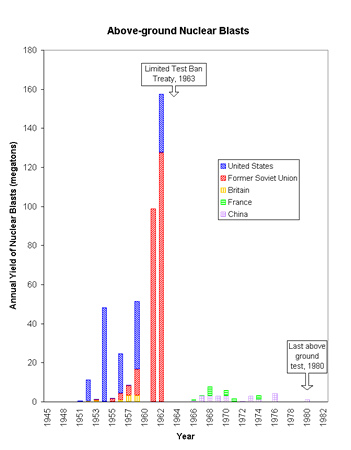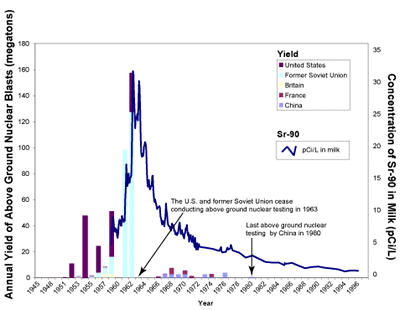Above-Ground Nuclear Blasts
Emergency Preparedness
and Response
The primary, but not only, purpose for the above-ground detonation of nuclear devices has been nuclear weapons testing. Other detonations involved experiments in earth excavation ("cratering"), basic physics, and rocket engine research.
On this page:
- How do nuclear devices contaminate the environment?
- What kind of contamination is in the fallout?
- How have people been exposed? What were the effects?
- When did the tests occur? Does RadNet data identify the contaminants?
How do nuclear devices contaminate the environment?
Detonating nuclear devices above ground can inject large quantities of radioactive material into the atmosphere. The explosion spreads the material from ground level up to very high elevations. Determining the exact type, amount, and fate of the fallout for any particular blast is difficult. It depends on the type of device, time and method of detonation, as well as regional and global weather patterns.
Large particles injected into the atmosphere tend to fall close to the explosion site. Smaller particles and gases are carried higher, likely to remain aloft, and can travel great distances on global air currents. They gradually return to earth as they slowly settle or are captured by falling rain drops.
Contaminants from large atmospheric explosions may remain for years or even decades in the stratosphere (the atmosphere above ground level air up to a height of fifty miles). These contaminants only gradually settle out as small deposits of fallout in the ground-level air (the troposphere) or onto the earth's surface.
What kind of contamination is in fallout?
Fallout typically contains hundreds of different radionuclides. Some of these persist in the environment for a long time because they have relatively long half-lives. Some have very short half-lives and persist in the environment for only a few minutes or a few years. Some produce high levels of radiation. Both long-lived and highly radioactive materials pose potential human health and environmental risks.
Some of the more important radionuclides detected by EPA's RadNet include:
RadNet monitoring stations also detect and routinely measure the radiation these radionuclides produce: alpha particles, beta particles, gamma rays.
How have people been exposed? What were the effects?
Exposure of people and other living things occurs by various routes or pathways. External or direct exposure comes from small amounts of fallout on the ground. Internal exposure occurs when radioactive particles are inhaled or when they are ingested following uptake by crops and livestock. Radionuclides that emit alpha and beta particles are less of an external exposure threat because they don't travel very far in the atmosphere. Alpha particles can be stopped by the dead cells on the skin's surface. Gamma rays travel much farther in the atmosphere and can penetrate the body.
Inhaled or ingested radionuclides continue to emit radiation directly to living tissue, increasing the risk of adverse health effects. The most notable effect is cancer resulting from damage to DNA in the cells. The health risks from fallout have been characterized in many studies.
When did the tests occur? Does RadNet's data identify the contaminants?
The graph below illustrates the estimated total annual yield of above-ground nuclear detonations by country and year. As seen in this figure, the total annual yield increases substantially in the late 1950s and early 1960's and then drops sharply following the Limited Test Ban Treaty of 1963.

Annual yield of above-ground nuclear detonations
by Country and Year
The first above-ground nuclear weapon test was conducted by the U.S. in southeastern New Mexico on July 16, 1945. Between 1945 and 1963, hundreds of above-ground blasts took place around the world. The number and size (yield) of blasts increased, particularly in the late 1950s and early 1960s. Following the signing of the Limited Test Ban Treaty of 1963 by the U.S., U.S.S.R., and Great Britain, most above-ground blasts ceased. (Some above-ground weapons testing by other countries continued until 1980.)
The ambient radiation monitoring systems in place at the time recorded sharp increases in atmospheric radiation as the number and size of the blasts increased. Following the signing of the treaty, the monitoring systems recorded the decreasing environmental concentrations of specific radionuclides.
A report by the United Nations Scientific Committee on the Effects of Atomic Radiation (UNSCEAR) in 2000, described how blast yields corresponded with global deposits of radionuclides such as strontium-90, cesium-137, and tritium (H-3).
The following graph shows how Sr-90 concentrations in milk measured by RadNet's predecessor ERAMS's data also correspond to blast yields. The the highest Sr-90 concentrations in pasteurized milk, seen in 1963, follow the intensive nuclear weapons testing of 1961-1962. After the majority of above-ground nuclear tests ceased in 1963, the Sr-90 level in pasteurized milk dropped sharply. Because other countries continued a small number of above-ground tests, the Sr-90 level reached a plateau rather than disappearing. Since the last above ground nuclear test in 1980, the Sr-90 in milk has steadily decreased as the radionuclide has decayed away.

![[logo] US EPA](https://webarchive.library.unt.edu/eot2008/20081106140200im_/http://www.epa.gov/epafiles/images/logo_epaseal.gif)
